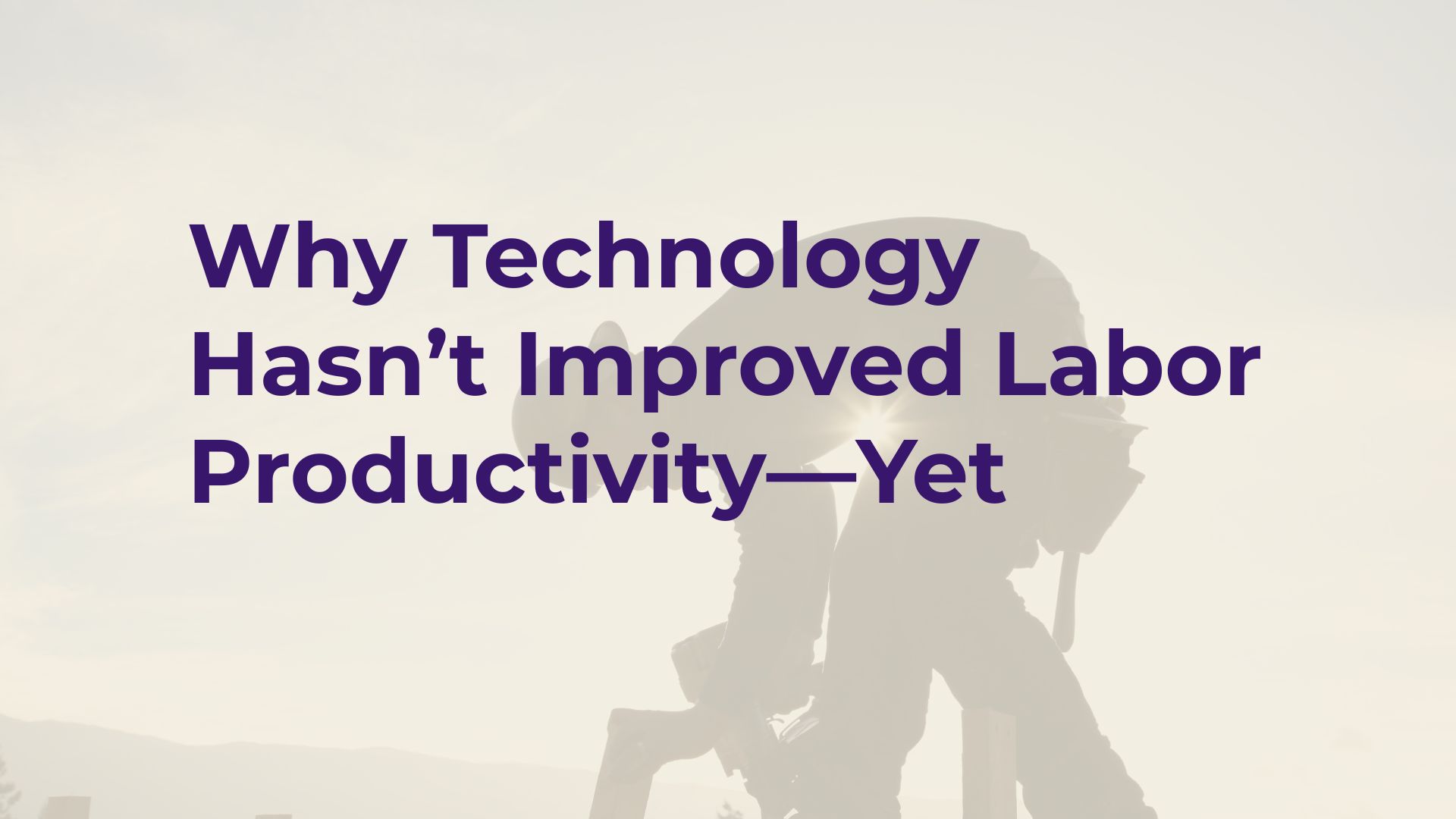
Introduction: The Tech Paradox
Over the last decade, construction has become one of the fastest-growing markets for software and digital tools. Billions of dollars have been invested in platforms to streamline workflows, digitize documents, and connect the field to the office.
And yet, labor productivity—the actual output of the workforce on a jobsite—hasn’t improved. In fact, according to the U.S. Bureau of Labor Statistics, productivity in construction has declined over the last several decades. Unlike manufacturing or logistics, the jobsite hasn’t gotten faster, more consistent, or more efficient.
This creates a paradox:
How can we have so much more technology—and yet still be doing the work the same way?
That’s the question this article explores.
What Software Has Improved
To be clear, software has made a real impact—especially in how construction is managed and documented. Over the last decade, contractors have adopted a wide range of digital tools to streamline the flow of information and improve coordination between the field and office.
The administrative and supervisory layers of a project now operate far more efficiently than they once did:
- Project managers can access drawings and specs from any device.
- Compliance forms, RFIs, and change orders can be submitted and tracked in real time.
- Supervisors can coordinate with office teams without paper logs or phone tag.
- Timecards are filled out digitally, making payroll and job costing easier.
- Daily reports are submitted via apps instead of clipboards or spreadsheets.
These tools have reduced friction, improved oversight, and created clearer communication across teams. They’ve helped contractors manage the work more efficiently—but they’ve done relatively little to improve the actual cost or pace of production on the jobsite.
The paradox is this: we’ve digitized how we manage construction, but we haven’t materially improved the productivity of those doing the building.
Where It Hasn’t Reached — The Field Productivity
Most of the gains from construction software have occurred at the administrative and management level. But for the vast majority of the workforce—the men and women physically building our infrastructure—technology has done far less.
Field labor still faces the same kinds of delays, miscommunications, and downtime that it did ten years ago. Tasks are still interrupted by missing materials, unclear instructions, or waiting on the next trade. Productivity on the ground hasn’t meaningfully changed—not because crews aren’t working hard, but because the tools haven’t reached the actual flow of their work.
This is where the gap lies. We’ve made it easier to track the work—but not to do it. We’ve optimized the office—but left the field behind.
Why It Hasn’t Reached Field Productivity
Software has improved how construction is managed—but boosting productivity in the field has proven much harder than expected. That’s not because contractors aren’t trying. It’s because the challenge is far more complex than most software vendors appreciate.
Here’s why:
1. Construction Is Physical, Not Digital
You can’t code your way to faster concrete finishing or straighter steel framing. Construction is grounded in physical labor—and software can’t make that labor more efficient any more than it can improve the productivity of a delivery driver by making the act of driving more efficient. These are “hard” jobs, not “soft” ones—the kind that aren’t naturally suited for software to optimize in the way it can for desk work or digital workflows. And that matters when thinking about where technology can and can’t move the needle.
2. Vendors Have Focused on the Low-Hanging Fruit
Most software companies have concentrated on areas where it’s easiest to show results: documentation, scheduling, dashboards, compliance. These improvements matter—but they primarily enhance management productivity, not the labor actually building the project. It’s much harder to create tools that support physical work in unpredictable environments. So that harder problem—the productivity of field crews—has largely been left unsolved.
3. Digital Skills Don’t Transfer Well
Construction workers often move from job to job, company to company. But unlike physical tools, most software doesn’t travel with them. Every company uses a different system—with its own interface, login process, and workflows. So even when workers learn a digital tool, that skill rarely transfers to the next job. Training centers and apprenticeship programs also struggle to prepare workers, because there’s no industry standard—just a patchwork of vendor-specific platforms.
4. The Workforce Is Too Dynamic for Traditional Training
Because digital skills don’t transfer from one job or company to the next, contractors that want to bring apps to their crew end up having to train every new worker—regardless of how experienced they are in their trade. That’s hard enough in a stable environment, but construction rarely offers that. Crews are large, constantly rotating, and often made up of workers with widely varying levels of tech familiarity. One-size-fits-all training doesn’t work in an environment where the user base changes week to week—and where most workers are more comfortable with a new power tool than a new mobile app.
5. Adoption Is a Culture and Timing Problem
Even when software is useful, getting crews to adopt it consistently is a different challenge. Many field professionals have spent years mastering tools that don’t need updates or logins—and for good reason. Their focus is on getting the job done, not managing apps. There’s also the timing problem: during busy times, there’s no time to implement new systems. When things slow down, it’s time to cut back—not experiment. To make matters worse, technology always seems to come with steep adoption barriers that don’t match the pace and pressure of the field.
Conclusion: Turning Technology into Real Productivity
For years, construction has invested heavily in software—but with little to show in terms of labor productivity. That’s not because the industry is resistant to change, but because the tools haven’t yet reached the work that matters most.
True progress will come when we stop asking software to document the past and start asking it to improve the present. That means building tools that target field crews’ productivity—not just documentation, compliance, or oversight.
The challenges are real—but so is the opportunity. In the next post, we’ll explore what it will take to finally make construction technology deliver on its long-promised potential for improving productivity.



